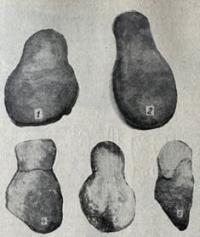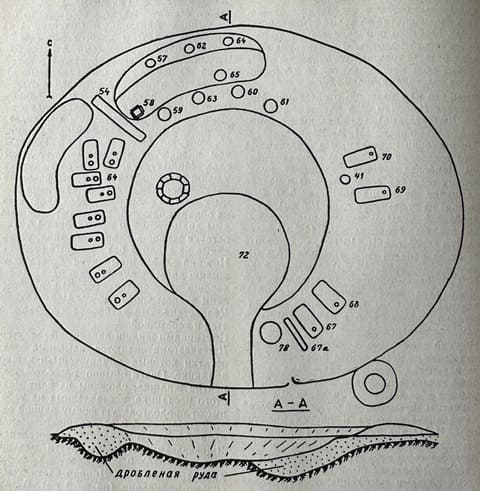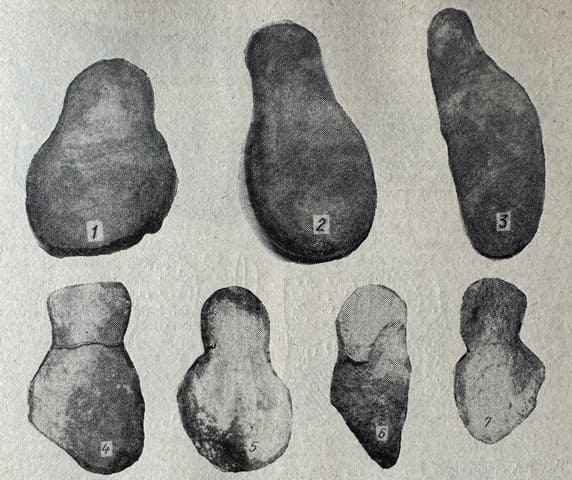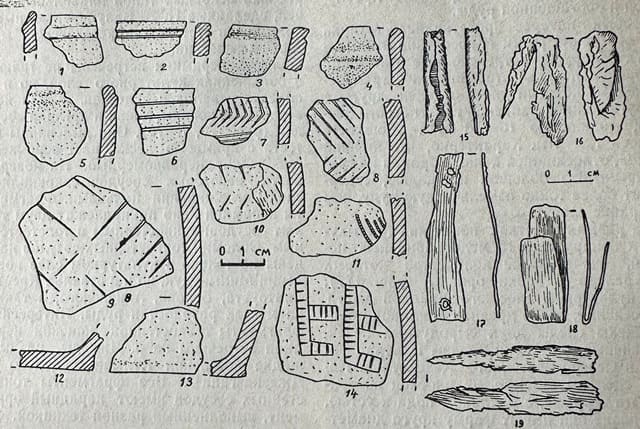You are here
Settlement of Milykuduk.

Ancient settlements in Dzhezkazgan.
“We owe everything that we know about the settlement of Milykuduk (as well as about other monuments of Zhezkazgan) to the tireless activity of N.V. Valukinsky.”
Alkey Margulan.
Melting furnaces in Ulytau.
The main town of Kazakh metallurgists is Milykuduk, located 12 kilometers southeast of the center of modern Zhezkazgan in the valley of the Zhezdy River, in a wide valley of the stream, 1 kilometer south of the center of the Dzhezkazgan mine in the Ulytau district of the region of the same name.
The settlement of Milykuduk was opened in 1929. The settlement of Milykuduk existed for a very long time, from the Bronze Age to the Middle Ages. The Kazakhs call it Elukuduk - 50 wells. The area of the settlement is very vast, its surveyed part measures 800 meters from west to east, about 600 meters from north to south, while the total area, according to the measurements of K.I. Satpayev, was at least 10 hectares.
Mylykuduk has long attracted the attention of geologists. The first deep trench in it was laid even before the revolution, when a large dump of crushed copper ore was discovered along with mining tools such as stone chippers, pestles, and mortars.
Wider and deeper trenches were laid on the initiative of the chief geologist of Dzhezkazgan K.I. Satpayev in 1939. Geologists pursued the goal of determining the thickness and volume of enriched ore produced in ancient times and at the same time probing the nature of the cultural deposits of the settlement.
The cultural remains of the settlement were exposed repeatedly during excavation work, especially during the construction of the railway track. In several places, in the section of the trenches, cultural layers with a thickness of about 2.5 meters were installed; brown clay lay underneath them.
We owe everything that we know about the settlement of Milykuduk (as well as about other monuments of Dzhezkazgan) to the tireless activity of N.V. Valukinsky. His excavations showed that the cultural layers of the Milykuduk settlement are uneven.
The thickest deposits of cultural remains are concentrated in the center of the site; their thickness reaches 3 meters. They consist of a soil layer (25 cm), a layer of crushed ore and cultural deposits of the late Middle Ages (1.2 meters), a layer of gray clay (15 cm), cultural remains of the early Middle Ages (0.8 meters), a layer of sandy loam (18 cm) , bottom layer (0.3 meters).
Thus, it has been established that Milykuduk has lower, middle and upper horizons, corresponding respectively to the Bronze Age, early and late Middle Ages. The lower layer differs sharply from the upper layers in the color of the clay and the remains of material production.
This layer is characterized by fragments of molded ceramics with patterns applied with a comb stamp, and the presence of tools made of quartzite, flint and other hard rocks. At the bottom of the lower layer, traces of four semi-dugouts were found in the form of shallow pits with the remains of hearths in the center.
The walls of the dwelling were lined with large slabs of sandstone, as evidenced by the large accumulation of stone slabs inside the pits and the surviving part at the entrance on the north side. The remains of semi-dugouts of a round or sub-square shape are located in rows, at a distance of no more than 1.5 - 2 meters.
The entrance was located from the northeast. The largest dugouts are I and 2 (8 x 9; 8 x 7 meters), the smallest dugout is 3 (5 x 6 meters). The depth of the pits is from 0.8 to 1.2 meters. The dwellings are oriented with their longitudinal axis in the direction of the prevailing wind, i.e. from WNW to ESE.
The same type of dwellings were found in the settlements of Ainakol and Sorkuduk. In terms of structure and other data, they are completely similar to the dwellings of the Atasu, Bugulin and Tagibaibulak settlements. The base of the dwelling certainly descends into a wide pit with sheer walls, over one meter high.
The internal walls are lined with large slabs of granite or sandstone. The pits were dug with stone picks, samples of which were found in significant quantities in the lower cultural layer of Milykuduk. The peculiarity of such dwellings is that the main load of the roof falls on the stone walls; no traces of support pillars are found along the walls.
There are paired pits with a diameter of 8 meters and a depth of 1.5 meters - the remains of a frame-type dwelling, built on pillars without stone walls. The lower layer of Milykuduk with the remains of the dwellings of ancient miners and metallurgists is well dated to the Begazy-Dandybaev stage of the Bronze Age of Central Kazakhstan.
This dating is also confirmed by ceramics. The companions of the dwellings of the ancient metallurgists of Dzhezkazgan are stone hearths, the remains of which were found in each dugout. The fires are usually located in the center of the dwelling, made of copper sandstone slabs placed on edge, have an oblong shape, about 2 meters long, 0.7 meters wide, and the thickness of the ash layer is 0.3 meters.
In the sites and settlements of Dzhezkazgan, smaller pockets were found. 0.4 x 0.3 meters of round shape with a diameter of up to 1 meter. The bottom part of the lesions is strongly calcined (by 8 - 9 cm). In the ash layer there were coals and small pieces of copper ore slag.
Flint tools and bones were found around the hearths. Among them are the bones of ram, horse, cattle, as well as wild animals - saiga and argali. Outside the hearth, a camel skull was found, which had a ritual character.
The lower cultural area has preserved the remains of a number of economic structures, for example, storage pits for storing enriched ore, as well as the remains of ancient dams, dams and wells lined with stones.
Dams are built at the top of a dry riverbed to regulate water near catchment areas. Large drainage pits, often more than 100 meters in diameter, were used for washing and wet flotation of copper ore. Around the drainage pits (remains of water basins) many storage pits, places of crushing and enrichment of copper ore were discovered, preserved in the form of mounds, dumps, splashes.
There are conical storage pits with a diameter of up to 10 meters and a depth of 1.5 meters; storage pits lined with sandstone slabs, up to 3 meters in diameter, up to 1 meter deep. At the bottom of the pits there are piles of finely ground ore, ready for smelting.
This gives reason to conclude that the pits, lined with sandstone slabs, served to store crushed and enriched ore. Of particular interest is the ore grinding technique. In the settlement of Milykuduk, three-layer deposits of crushed ore dating back to three periods were discovered; Each layer is separated from each other by a thickness of gray alluvial clay, 16 - 18 cm thick.
The thickness of the layers is 1.5 - 2 meters. It is characteristic that the lower layer, dating back to the Bronze Age and limited to a small area, contains more finely ground ore than the upper layers. In different parts of the Milykuduk settlement, 15 copper smelting furnaces were discovered, a significant number of which were left from the Bronze Age.
In the cultural layer of the southwestern part of the settlement, near the ancient dugouts, traces of two cheese-blowing ovens were discovered, typical of the Bronze Age of Central and North-Eastern Kazakhstan.
The ovens are made in the ground, on a flat surface of the terrace, with the hearth sloping towards the mouth. In plan they have the shape of a circle with a diameter of 4 meters and a depth of 2 meters. The walls are lined with slate slabs; the vault in the form of a truncated cone served as a chimney.
The walls of some furnaces were coated with clay, as evidenced by clay lumps with traces of human fingerprints preserved in the ash layer of the furnaces. In the same part of the settlement, another type of furnace was found, up to 4 meters long, 0.8 meters wide, dug in the ground without tilting the hearth.
In general, Bronze Age ovens are small, round, 3 to 4 meters in diameter, and 1 to 2 meters deep. They were often located on sloping terraces near water or in river valleys. According to the observations of N.V. Valukinsky, Dzhezkazgan furnaces had different purposes: for burning coal, for crushing ore before the recovery period, for smelting burnt and crushed copper ore in crucibles, for heap roasting.
n the bottom part of all smelting furnaces, coals, pieces of slag, copper balls, etc. were preserved. Sketches of the main types of smelting furnaces made by N.V. Valukinsky are now stored in the Dzhezkazgan Historical and Local Lore Museum.
eramic fragments were found not only in outcrops of the cultural layer, but also in the edges of dumps and splashes. Among them are rims, sides, bottoms and lids of vessels. They are made from dough mixed with sand, the color is gray-yellow, the firing is uneven.
On the surface of some vessels there are traces of smoothing with fingers. The ceramic fragments clearly belong to two types of vessels: thin-walled and thick-walled. Fragments of thin-walled vessels were found not only in the cultural layer of the Milykuduk settlement, but also in the dumps of Kresto, Zlatoust, Belov, Annensky, as well as at ore mining sites.
Interesting fragments of thin-walled polished ceramics were found on the Dzhezdy River, at the site of the Kulman settlement, not far from Dzhezkazgan. All fragments of thin-walled vessels have elegant ornaments made using different techniques.
The predominant stamp impressions are comb, pitted, smooth-linear types, carved horizontal grooves, notches, herringbones, ribbon patterns with oblique shading, an ornament of rows of E-shaped meander figures shaded with transverse notches, etc.
The indicated elements of ornament are very typical for ceramics of the Late Bronze Age. Relatively few bronze items were found, about a dozen. Among them, semi-finished products and copper plates predominate; there are almost no whole, brighter samples.
The most interesting is a fragment of the working end of a large tetrahedral pickaxe, found in the Kresto dumps. The discovery of this large tool in the ancient dumps of Dzhezkazgan indicates that the miners used not only powerful stone picks, but also copper picks.
Copper picks of a tetrahedral shape with two working ends are widespread throughout Central and North-Eastern Kazakhstan. In the past, they were found in ancient mine dumps of the Karkaraly steppe. Their samples are now kept in the Semipalatinsk Museum, the Hermitage and the State Historical Museum.
In the lower layer of Milykuduk, a significant amount of bones of cattle, horses, and camels were found, including processed ones, for example, a well-sharpened bone knife, apparently used for cutting clay, a shoulder blade of a large animal (horse), ¬lived as a scoop for raking up crushed ore, ash and garbage.
In addition, bones of wild animals were found - saiga, kulan, argali skull with cut off horns, indicating the secondary importance of hunting. A fair number of mining tools were discovered in the cultural layer and at the bottom of the workings: hammers, hoes, picks, hammers, pestles, crucibles, etc.
Below is their description compiled by N.V. Valukinsky. Large striker 1 is a round-shaped percussion type weapon. Discovered in the ancient dumps of the Cross Center. The largest of all types of quartzite tools and the most powerful, weighing up to 40 kilograms.
The large diameter is 44 cm, the small one is 32 cm. The tool is designed for a strong blow from above on hanging rocks and ores (cohesion of ore veins), its use requires the efforts of two workers. The main working part was the lower worn side with traces of long-term use.
Large bumper 2 of polyhedral shape. Found in the dumps of Petro III. Made from a relatively large quartzite boulder weighing up to 22 kilograms. Has the same purpose as bumper 1. Large bumper 3 has a multifaceted notched shape, made specifically for easy grip by hand.
Found on the Kresto Dentra dumps. Made from Dzhezkazgan quartzite. The working part is the bottom side. Large bumper 4 is exactly the same as the previous one. Made from quartzite. The recess for the handle is slightly deeper than on the previous weapon.
Found on the dumps of Zlatoust. Large bumper 5 has a notched shape, made for easy hand grip. The notch is made on the hillock part of the quartzite boulder, flat, working, side down. Found in the ancient workings of the Cross Center. Large bumper 6 is made of quartzite in a spheroid shape.
The working part is all protruding surfaces. Found on the dumps of Zlatoust. Large bumper 7 is made from a whole quartzite boulder in the shape of an irregular ball, the working side is the bottom. Found on the ancient dumps of Petrokholm.
The bumper 8 is notched-spherical in shape with a working part on one side. The second series of tools for mining and sorting ore are represented by large stone hammers like a powerful sledgehammer, roughly processed in the shape of two balls or a rectangular parallelepiped with a recess in the middle for attachment to a wooden handle.
Large stone hammer I is made in the form of two equal spheroids with recesses in the middle from a large boulder of dark brown quartzite. One half is beaten off. Weight up to 8 kilograms. The entire surface is well hewn and ironed.
Served for driving wedges into rock cracks and for splitting large blocks of rock. Found in ancient workings north of Zlatoust. Large stone hammer 2(4) is made from a piece of red sandstone in a cylindrical shape with two equal balls.
N.V. Valukinsky in the cultural layers of the settlements of Milykuduk, Ainakol, Sorkuduk in the ancient workings and dumps of the Cross Center, Petro and Zlatoust found a large series of stone wedges that served for breaking off rocks and huge blocks of rock.
They were driven with a large stone hammer into the cracks of the rocks and thus destroyed entire layers and deposits. Below is a brief description of stone wedges. Wedge 1(8) is made of quartzite, has an oval shape, the surface is rough, beaten.
Found in the ancient dumps of Chrysostom. Wedge 2(9) is absolutely the same as the previous one. Found in the ancient dumps of Zlatoust. Wedge 3 (13) made of quartzite, is a rectangular block with a conical end, roughly beaten on top.
Found on the dumps of the Cross Center. Wedge 4(12) is made of quartzite, has the appearance of a triangular stone with a straight base and a conical end. Found in the dumps of Chrysostom.



Authority and photos by:
"Begazy-Dandybaevskaya culture of Central Kazakhstan." A. Kh. Margulan.
Academy of Sciences of the Kazakh SSR. Institute of History, Archeology and Ethnography named after Ch.Ch. Valikhanova. Almaty-Ata. 1979






